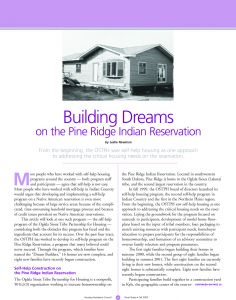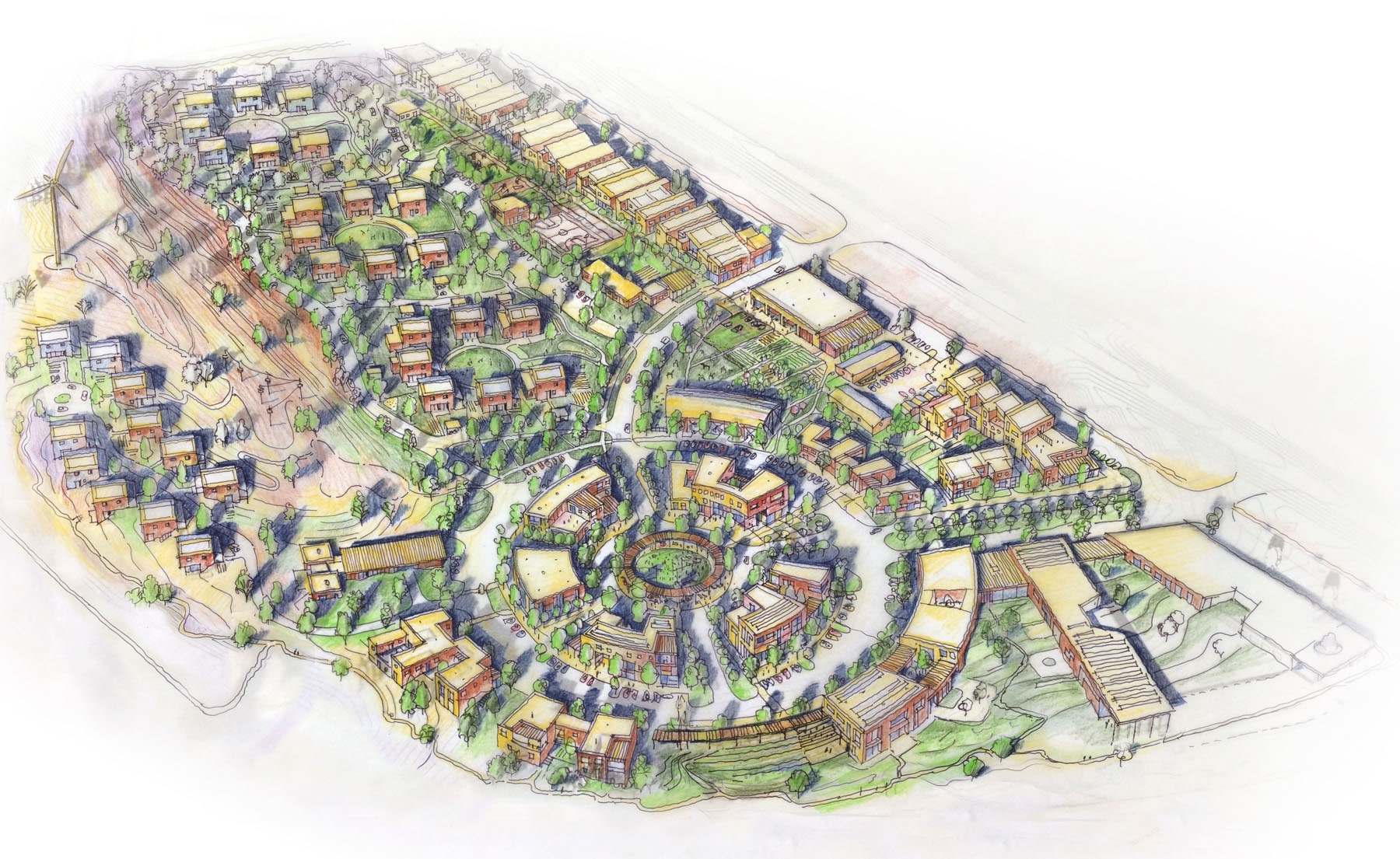20 Years of Rural Voices
Rory Doyle / There Is More Work To Be Done
Rory Doyle / There Is More Work To Be Done
by Leslie Newman
 This story appears in the 2015 Fall Edition of Rural Voices
This story appears in the 2015 Fall Edition of Rural Voices
“Self-help is not a new concept for us. We were always self-help, traditionally. We always built our own homes. We didn’t wait. We have to get away from this dependence and go back to protecting our own assets. A long time ago, if a teepee tore, they didn’t wait for someone else to come sew it up. We had to have that shelter.” –Pinky Clifford, Executive Director, Oglala Sioux Tribe Partnership for Housing
by Leslie Newman
 This story appears in the 2015 Fall Edition of Rural Voices
This story appears in the 2015 Fall Edition of Rural Voices
“Self-help is not a new concept for us. We were always self-help, traditionally. We always built our own homes. We didn’t wait. We have to get away from this dependence and go back to protecting our own assets. A long time ago, if a teepee tore, they didn’t wait for someone else to come sew it up. We had to have that shelter.” –Pinky Clifford, Executive Director, Oglala Sioux Tribe Partnership for Housing.
 In fall 2003, we looked at a new self-help housing program on the Pine Ridge Indian Reservation, developed by the Oglala Sioux Tribe Partnership for Housing (OSTPH). We looked at what it took to create the program, some challenges to self-help housing on tribal trust land, and ingredients for success.
In fall 2003, we looked at a new self-help housing program on the Pine Ridge Indian Reservation, developed by the Oglala Sioux Tribe Partnership for Housing (OSTPH). We looked at what it took to create the program, some challenges to self-help housing on tribal trust land, and ingredients for success.
Now, going back to Pine Ridge more than ten years later, we find that self-help is alive and well. While the OSTPH is no longer operating a USDA Rural Development self-help program, it is still committed to the self-help concept, and another organization, Thunder Valley Community Development Corporation, has recently been awarded Section 523 funding from Rural Development to develop and launch a self-help pilot. Through a unique collaborative effort, the Sustainable Home Ownership Program (SHOP) collaborative, the two organizations and other partners are working together to promote homeownership on Pine Ridge and support each other’s efforts.
The Oglala Sioux Tribe Partnership for Housing is a private, nonprofit organization promoting homeownership and developing viable housing options for people on the Pine Ridge Indian Reservation. Over the past 16 years, OSTPH has worked to promote homeownership there, providing homeownership education and counseling, assisting families in applying for home mortgages, and building homes to meet the severe housing shortage on the reservation. The organization has assisted over 90 families in purchasing homes. Through its self-help program, a total of 24 families worked together to build their own homes. These homes are scattered in different districts around the reservation, an area spanning approximately 40,000 square miles (the size of the state of Connecticut).
After these 24 families constructed their homes, the organization determined that it would pursue self-help housing in other ways. According to executive director Pinky Clifford, “Self-help with Rural Development is one thing, but there are other options to look at.” OSTPH is currently working with partners to design and develop a “tiny house” program, enabling families to work together to build a home that could be moved easily on a flatbed truck to a location of their choice (it would not require special house-moving equipment). Learning from their experience working simultaneously with multiple families across the reservation, the OSTPH envisions that with its new self-help programming, participating families will completely build one home, and then start building the next. “We’re looking at self-help, one family at a time,” explains Clifford. The OSTPH sees the “tiny house” program as a key to long-term asset-building, as families can build onto the small house over time, or sell a house to another family and use the equity as a down payment to buy another home.
In order to address the need for improvements to existing homes, the OSTPH is also looking at a self-help rehab program. According to Clifford, “there are hundreds and hundreds of homes that need to be rehabbed. We’re looking for innovative ways to access resources to make this happen.”
Thunder Valley Community Development Corporation is an Oglala-led, Native American 501(c)(3) nonprofit organization based out of the Thunder Valley community of the Porcupine District on the Pine Ridge Indian Reservation. Its mission is “empowering Lakota youth and families to improve the health, culture, and environment of our communities, through the healing and strengthening of cultural identity.” Thunder Valley is currently implementing a comprehensive community development initiative, which includes the creation of homeownership opportunities, a youth shelter, an empowerment center, community gardens, a walking/hiking/biking trail, a business incubator, commercial space, a bunkhouse for volunteers and students, and powwow grounds.
Thunder Valley sees the self-help approach as an important piece of its comprehensive efforts to build a community, and emphasizes that its program builds on the work and experience of the OSTPH. According to executive director Nick Tilsen, “We don’t believe that Thunder Valley would be afforded the opportunity to take on self-help on Pine Ridge if Pinky and the [Oglala Sioux Tribe] Partnership hadn’t done it before and paved the way. They showed that self-help can be done. We wanted to take it on because it works.”
In developing its self-help pilot program, one of Thunder Valley’s first steps focused on learning about the OSTPH efforts. Liz Welch, Thunder Valley’s director of advancement, explains that “the Partnership was transparent and open to share their experience, both what worked and what was really challenging. Without that, we wouldn’t have taken it on.”
Rather than scattered sites, Thunder Valley self-help participants will be building homes in the Thunder Valley development in Porcupine. According to Tilsen, community and relationship building is a major reason that Thunder Valley believes in the self-help model: “Because we’re building an actual physical community – beyond building homes, we’re trying to build relationships between the families. By helping one another build their houses, we’re building positive, healthy relationships between neighbors.”
 Architectural rendering of Thunder Valley’s Regenerative Community Development Plan, courtesy of Thunder Valley CDC
Architectural rendering of Thunder Valley’s Regenerative Community Development Plan, courtesy of Thunder Valley CDC
Like many self-help programs around the country, Thunder Valley recognizes that sweat equity is key to making homeownership affordable for low-income families and to long-term asset building. Affordability also underlies the organization’s commitment to green building and energy-efficient construction. “We’re on a pathway,” Tilsen explains. “Our end goal is to build affordable housing with net-zero energy costs. We strongly believe that low-income families shouldn’t be dumping their limited resources into utility bills and high energy costs. Instead, we want them to put their resources into building assets.” Thunder Valley’s energy efficient construction includes using passive solar design (orientation of homes, placement and size of overhangs), as well as solar panels and solar thermal systems.
Thunder Valley is currently focusing on infrastructure development for its new community (roads, water, sewer) and preparing its first group of six self-help families. Through its pilot program, a total of 12 families will build their new homes in the development; the first six are scheduled to begin construction in the spring/summer of 2016.
In looking at self-help housing in Pine Ridge back in 2003, it was clear that collaboration was key to the success of homeownership efforts. In speaking with the OSTPH and Thunder Valley today, this spirit of partnership is still apparent, if not stronger. Through the SHOP collaborative, Thunder Valley and the OSTPH are working with other partners to streamline the homeownership process on Pine Ridge and support one another’s efforts. Through the collaborative, partners have developed a shared training calendar, make IDA program homeownership referrals, and share other homeownership opportunities. Tilsen explains, “We are working to support and promote each other’s efforts. Even if a potential homebuyer isn’t a good fit for our program, we can refer them to one of our partners. The only way we know about other opportunities and what our partners can offer is by collaborating and working together.”
Back in 2003, we saw that developing self-help housing on Pine Ridge was not an easy task, and this has not changed. The joint efforts and partnerships we see today are a critical part of successful self-help housing efforts and providing homeownership opportunities for tribal members, and a model for other communities around the country.
Leslie Newman is a founder and co-manager of Seven Sisters Community Development Group, which focuses on community development in Native communities. She has been working to support affordable housing and asset building on the Pine Ridge Reservation since 1999.